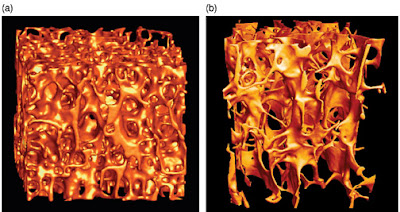Cancellous bone is characterised by a honeycomb arrangement, comprising a network of trabeculae (rod-shaped tissue). These structures provide support and strength to the bone. The spaces within this tissue contain bone marrow (not seen), a blood forming substance.
The surface of the cementless ESKA Endoprostheses is a three-dimensional grid structure that has been adapted to the structure of the cancellous bone and affords vascularisation of the bone. The dimensions – structural height and web thickness – of this interconnecting surface are part of the technical specifications and are therefore reproducable. The structure and the implant core are manufactured in a one-piece homogeneous casting process. Primary stability is achieved by press-fit, long-term stability is achieved by bony integration. This three-dimensional web structure has been successfully applied for more than 25 years.
A three-dimensional synchrotron computed-tomography image of a 4-millimeter-cube of trabecular bone from the vertebra interior of a 30-year-old female shows bone of normal density and architecture. A significant number of trabeculae and platelike structures are aligned in the load-bearing direction.


